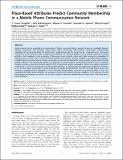| dc.contributor.author | Eagle, Nathan N. | |
| dc.contributor.author | Caughlin, T. Trevor | |
| dc.contributor.author | Ruktanonchai, Nick | |
| dc.contributor.author | Acevedo, Miguel A. | |
| dc.contributor.author | Lopiano, Kenneth K. | |
| dc.contributor.author | Prosper, Olivia | |
| dc.contributor.author | Tatem, Andrew J. | |
| dc.date.accessioned | 2013-04-16T17:29:21Z | |
| dc.date.available | 2013-04-16T17:29:21Z | |
| dc.date.issued | 2013-02 | |
| dc.date.submitted | 2012-07 | |
| dc.identifier.issn | 1932-6203 | |
| dc.identifier.uri | http://hdl.handle.net/1721.1/78553 | |
| dc.description.abstract | Social networks can be organized into communities of closely connected nodes, a property known as modularity. Because diseases, information, and behaviors spread faster within communities than between communities, understanding modularity has broad implications for public policy, epidemiology and the social sciences. Explanations for community formation in social networks often incorporate the attributes of individual people, such as gender, ethnicity or shared activities. High modularity is also a property of large-scale social networks, where each node represents a population of individuals at a location, such as call flow between mobile phone towers. However, whether or not place-based attributes, including land cover and economic activity, can predict community membership for network nodes in large-scale networks remains unknown. We describe the pattern of modularity in a mobile phone communication network in the Dominican Republic, and use a linear discriminant analysis (LDA) to determine whether geographic context can explain community membership. Our results demonstrate that place-based attributes, including sugar cane production, urbanization, distance to the nearest airport, and wealth, correctly predicted community membership for over 70% of mobile phone towers. We observed a strongly positive correlation (r = 0.97) between the modularity score and the predictive ability of the LDA, suggesting that place-based attributes can accurately represent the processes driving modularity. In the absence of social network data, the methods we present can be used to predict community membership over large scales using solely place-based attributes. | en_US |
| dc.language.iso | en_US | |
| dc.publisher | Public Library of Science | en_US |
| dc.relation.isversionof | http://dx.doi.org/10.1371/journal.pone.0056057 | en_US |
| dc.rights | Creative Commons Attribution | en_US |
| dc.rights.uri | http://creativecommons.org/licenses/by/2.5/ | en_US |
| dc.source | PLoS | en_US |
| dc.title | Place-Based Attributes Predict Community Membership in a Mobile Phone Communication Network | en_US |
| dc.type | Article | en_US |
| dc.identifier.citation | Caughlin, T. Trevor et al. “Place-Based Attributes Predict Community Membership in a Mobile Phone Communication Network.” Ed. Angel Sánchez. PLoS ONE 8.2 (2013): e56057. | en_US |
| dc.contributor.department | Massachusetts Institute of Technology. Media Laboratory | en_US |
| dc.contributor.mitauthor | Eagle, Nathan N. | |
| dc.relation.journal | PLoS ONE | en_US |
| dc.eprint.version | Final published version | en_US |
| dc.type.uri | http://purl.org/eprint/type/JournalArticle | en_US |
| eprint.status | http://purl.org/eprint/status/PeerReviewed | en_US |
| dspace.orderedauthors | Caughlin, T. Trevor; Ruktanonchai, Nick; Acevedo, Miguel A.; Lopiano, Kenneth K.; Prosper, Olivia; Eagle, Nathan; Tatem, Andrew J. | en |
| mit.license | PUBLISHER_CC | en_US |
| mit.metadata.status | Complete | |
